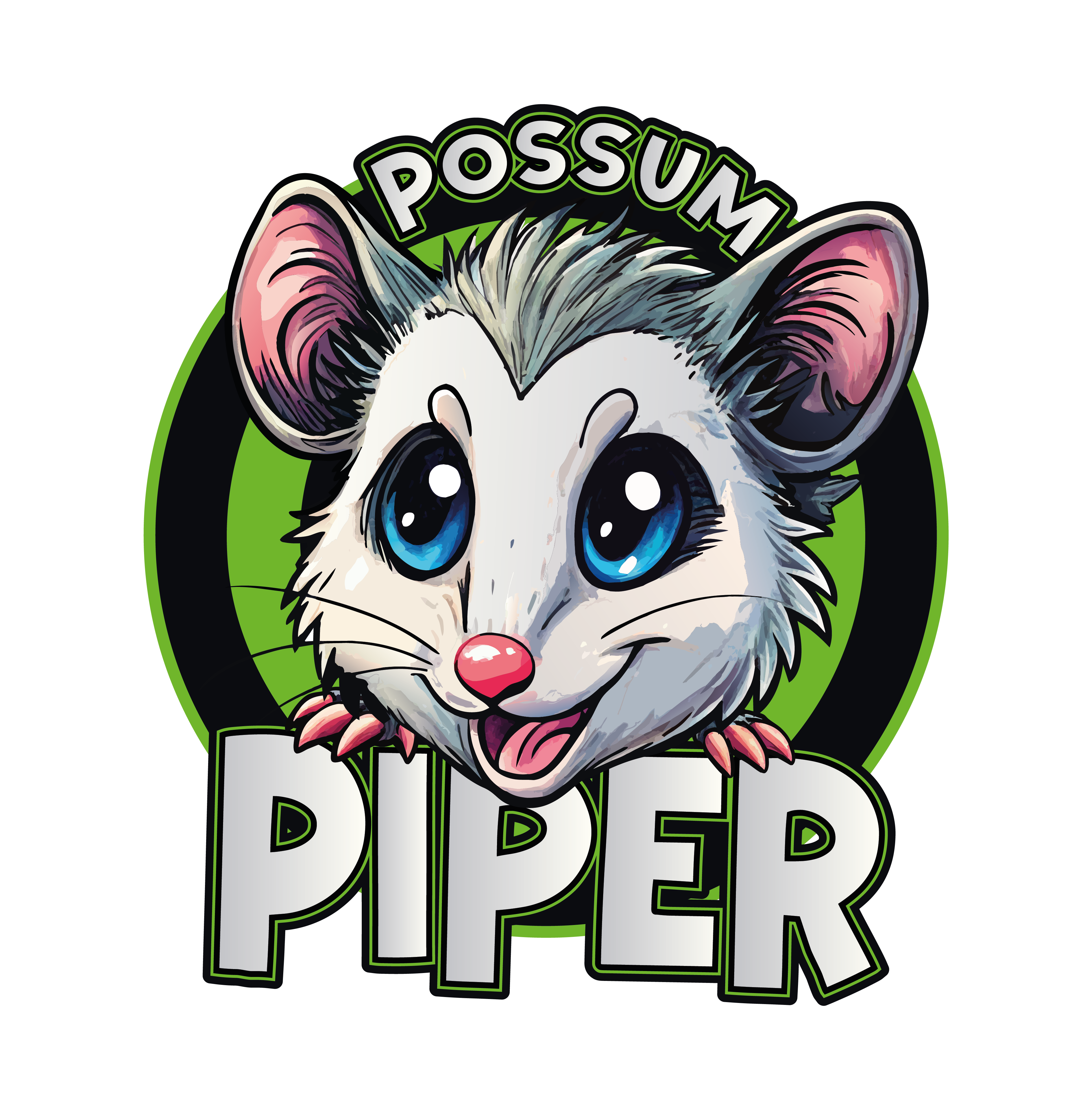
Possum territorial battles with humans has been ongoing ever since domestic life evolved in Australia.
As enchanting as they may seem, possums can become a significant problem when they decide to reside in your home or business premises.
These nocturnal creatures are known for their destructive behaviour, often causing damage to gardens, buildings, and electrical wiring. Effective possum control is essential for maintaining a safe and healthy environment.

Table Of Contents:
- Possum Identification on Your Property
- Possum: Understanding Their Behaviour
- Possum Noises: Brushtails and Ringtails
- Possum Foods and Identifying Possum Poo
- Possum Nesting Habits And Breeding Cycle
- Possum Defensive Mechanisms
- Possum Removal: Essential Techniques
- Possum Repellent and Possum Deterrents
- Possum: The Benefits of Professional Removalists
- Managing a Dead Possum Dilemma
- Possum Catch and Release Licence Legalities
- Protecting Yourself From Potential Risks Associated With Possums
- Rodent Control: What Works?
-
Possum Frequently Asked Questions
- Are Possums a pest in Australia?
- Are Australian Possums friendly?
- Are Possums a danger?
- What is the difference between a Ringtail possum and a Brushtail possum?
- What is the difference between an Opossum and an Australian possum?
- Can you touch an Australian Possum?
- What is the most common possum in Australia?
- How many different types of possums are there?
- Are possums protected in Australia?
- How rare are Ringtail Possums?
- Will installing a barrier on powerlines prevent Possums from accessing my roof?
- How do you get rid of Possums permanently?
- Do WIRES remove possums from my roof?
- Does the RSPCA remove possums from my roof?
- Does Sydney Wildlife Rescue remove possums from my roof?
- Do Pest Control Companies Remove Possums from My Roof?
- Conclusion
Possum Identification on Your Property
These furry creatures are often seen scampering around at night, but how do you know what type of possum is visiting? Australia hosts various possum species and identifying them requires keen observation.
There are two common possums prevalent in suburban gardens of Australia: Common Brushtail Possums and Ringtail Possums; if you have a Possum issue, you might see them in your garden at night.
The Brushtail Possum
The Common Brushtail Possum, as its name suggests, has an unmistakable bushy tail. It's the largest urban dwelling possum with grey fur and large ears. You might hear their loud hisses during territorial disputes.
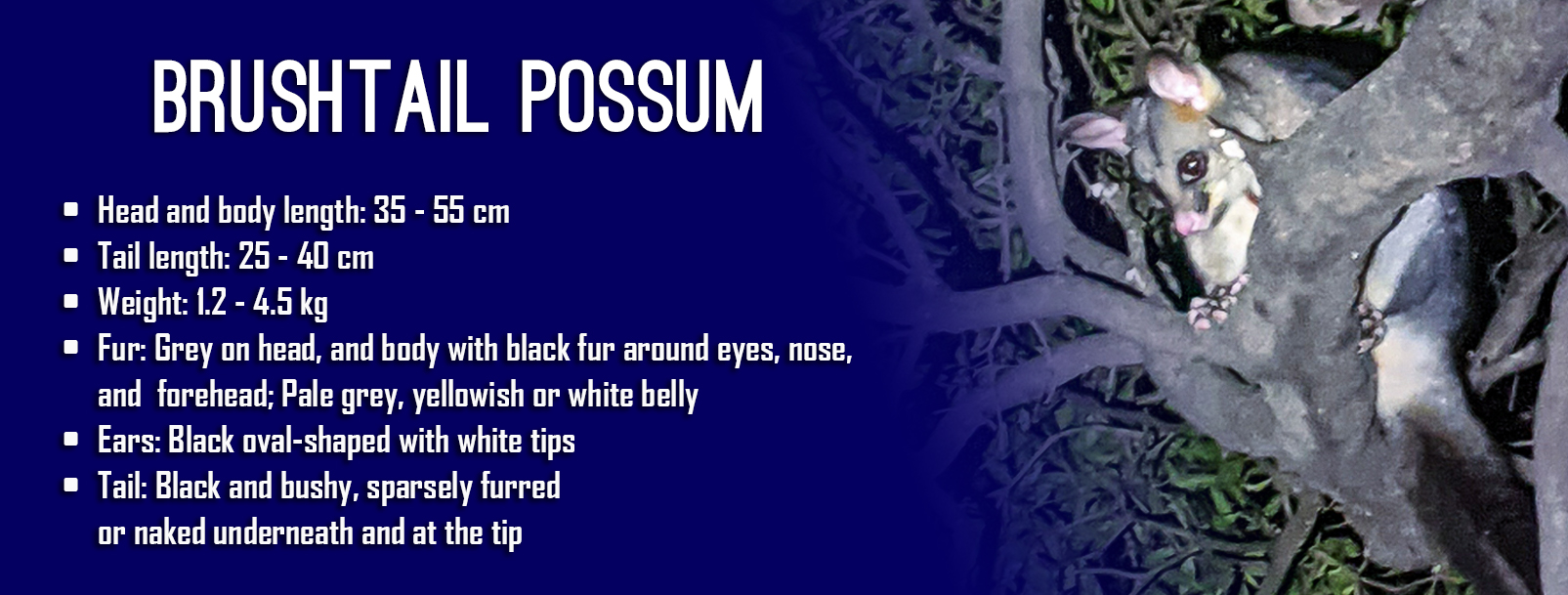
The Ringtail Possum
Ringtail Possums (pseudocheirus peregrinus) are smaller than their Brushtail counterparts, with brown fur and distinctive white patches behind their ears. Their white-tipped prehensile tail curls into a ring when carried, giving away their identity instantly.
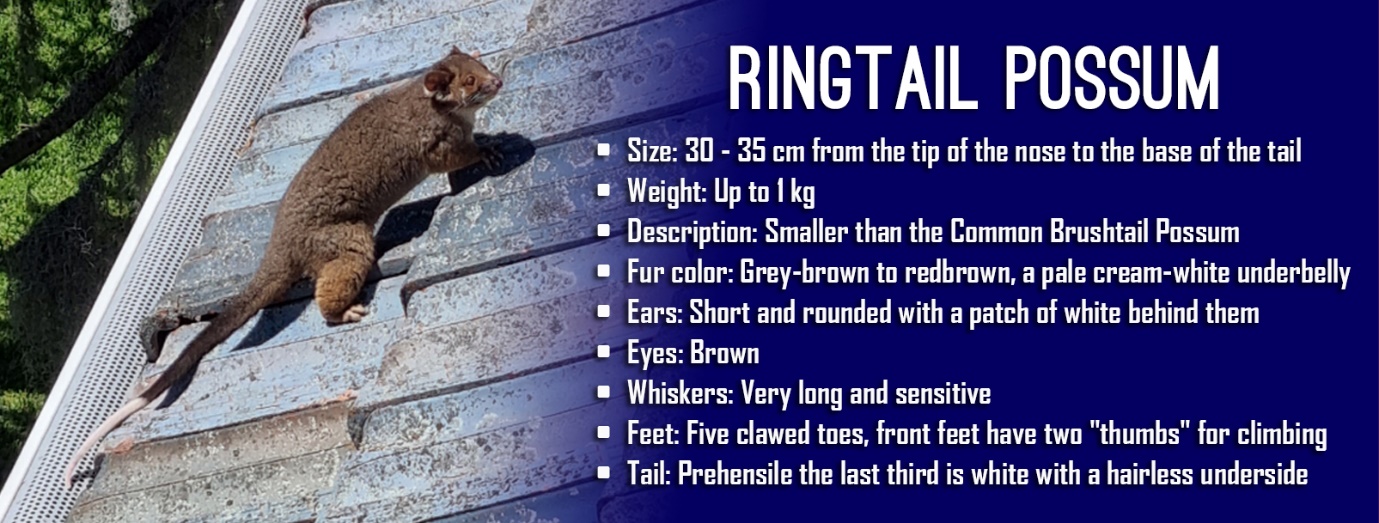
Other Less Known Australian Possum Species.
The pygmy possums are a family of small possums that together form the marsupial family Burramyidae. The five extant species of Pygmy Possum are grouped into two genera. Four of the species are endemic to Australia, with one species also co-occurring in Papua New Guinea and Indonesian Islands
The Mountain Pygmy Possum (Burramys parvus) is a tiny marsupial native to Australia, weighing only 45 grams. It's primarily nocturnal and inhabits alpine rock screes and boulder fields, with its main population found in southern Victoria and around Mount Kosciuszko in New South Wales' Kosciuszko National Park.
The Western Pygmy Possum, (cercartetus concinnus) also known as the southwestern pygmy possum or the mundarda, is a small marsupial found in Australia. Genetic studies indicate its closest relative is probably the eastern pygmy possum, from which its ancestors diverged around eight million years ago.
The Tasmanian Pygmy Possum (Cercartetus lepidus), also known as the little pygmy possum or tiny pygmy possum, is the world's smallest possum.
The Mountain Brushtail Possum, or Southern Bobuck (Trichosurus cunninghami), is a nocturnal, semi-arboreal marsupial of the family Phalangeridae native to southeastern Australia.
The Coppery Brushtail Possum is a species of marsupial possum in the family Phalangeridae. Coppery brushtails are found within the Atherton Tablelands area of Queensland, in northeastern Australia. These mammals inhabit rainforest ecosystems, living within the tree canopy.
The Western Ringtail Possum or ngwayir is a species of possum found in a small area of Southwest Australia. They are a cat-sized marsupial with a stocky build, dark greyish-brown fur, pale underparts and a long prehensile tail with a whitish tip.
The Scaly-tailed Possum (Wyulda squamicaudata) is found in northwestern Australia, where it is restricted to the KimberleyThe Lemuroid Ringtail Possum (Hemibelideus lemuroides), also known as the Lemur-like Ringtail Possum or the Brushy-tailed Ringtail. Named for their facial characteristics, visually similar to the unrelated primate Lemurs, with short snouts, large, forward-facing eyes and small ears The Herbert River Ringtail Possum (Pseudochirulus herbertensis) is a species of possum found in northeastern Queensland, Australia.
The Rock-haunting Ringtail Possum (petropseudes dahli), also known as the Rock Ringtail Possum, is a species of Australian possum. It is found in rocky escarpments in the Kimberley, Arnhem Land and Gulf of Carpentaria across Western Australia and Northern Territory and just passing the Queensland border.
The critically endangered Leadbeater's Possum (Gymnobelideus leadbeateri) is primarily found in small areas of alpine ash, mountain ash, and snow gum forests in Victoria's Central Highlands, northeast of Melbourne. This species is unique for its primitive, non-gliding nature and is considered an ancestral form, being the sole representative of the petaurid genus Gymnobelideus. They also go by the common name of Fairy Possum.
Possum: Understanding Their Behaviour
The behaviour of possums is intriguing and often misunderstood. Understanding how these creatures interact with their environment can help us manage them effectively.
Possum's Nocturnal Nature
Possums are nocturnal; their sharp vision and olfactory senses allow them to move in the dark easily.
Possums create loud scratching, thumping, or scampering sounds in attics, ceilings, or in roof spaces; these sounds usually occur when they leave to feed
They tend to follow a consistent routine, leaving at the same time at night, between dusk and 11 p.m. and returning at roughly the same time the following morning, between 3 a.m. and dawn.
When they are out foraging for food and water between 11 pm and 3 am, you're unlikely to hear any noises associated with Possums in your roof, also during the day unless they are occasionally moving around or scratching in their sleep for a few seconds at a time.
If you are hearing noises such as running, scurrying or constant scratching between 11 pm and 3 am, we can conclude it will be rat activity, in which case it is paramount you carry out rat control treatments.
If noises are being heard from dawn to dusk., this may also suggest rodent activity, as they lack a fixed schedule. Rodents can be heard tapping, scurrying, and squeaking.
Possum Noises: Brushtails and Ringtails
Despite being solitary creatures, possums have complex social structures marked by territory dominance and hierarchies, with communication carried out through scent markings and vocalisations.
What Sound Does a Possum Make?
Common Brushtail Possums make growling calls, loud shrieks & rasping calls. Ringtail Possums make soft chirps and squeaks.
Related
Possum Foods and Identifying Possum Poo
Brushtail Possums have a diet primarily composed of plant matter, including leaves from eucalyptus trees and certain shrubs, along with flowers, fruits, and herbs.
They also consume bird eggs, young birds, and some insects. These possums exhibit a flexible feeding behaviour, foraging in forest canopies, lower forest levels, and on the ground.
In urban environments, they adapt to consuming various foods, such as fruits and bread, to meet their dietary needs.
The primary diet for the Common Ringtail Possum consists of eucalyptus leaves, but they also consume fruits, flowers, and leaves from various native trees. Additionally, in suburban settings, they have been observed feeding on rose buds
Brushtail possum poop measures around 15 mm, varying in colour from greenish-brown to dark brown or black based on their diet.
Ring-tailed possum droppings are about 10 mm long, slightly shorter than brushtail possums. Their colour ranges from dark brown to black, appearing as irregular pellets similar in thickness to a Bic pen.

Related
Possum Nesting Habits And Breeding Cycle
Regarding nesting habits, Brushtail Possums prefer tree hollows or, in the instance of Ringtail Possums, nests called Dreys made of dense foliage fashioned into a nest or similar sheltered spots.
But when these natural options are scarce (as is common in urban areas), most Australian possums may resort to roof cavities or garages - an issue many homeowners face.
The Common Ringtail Possum becomes sexually active at 13 months old. Their gestation period lasts from 20 to 26 days, resulting in the birth of one to two (sometimes up to four) joeys.
These offspring are born hairless and are about the size of a jellybean. Typically, they have one litter per year; their breeding season is between April and November.
Following birth, the young possums will make their way to the mother's pouch. After seven weeks, they'll leave the pouch and ride on their mother's back until they're weaned at about six months.
Both parents share the responsibility of caring for the young. The father takes a turn carrying them on his back while the mother attends to feeding.
Female Brushtail Possums typically give birth to a single young (mostly between March and May), carrying them in their pouch for up to 5 months.
When the young possum outgrows the pouch, it usually rides on its mother's back, a practice that continues until it's about nine months old and capable of self-feeding. Females generally start breeding after their first year and may raise young annually.
While few young possums perish in the pouch, between 6 and 18 months of age, many face mortality while trying to establish their home ranges away from their birth area.
Among these, males are particularly vulnerable due to territorial conflicts, making up only one-third of the adult population.
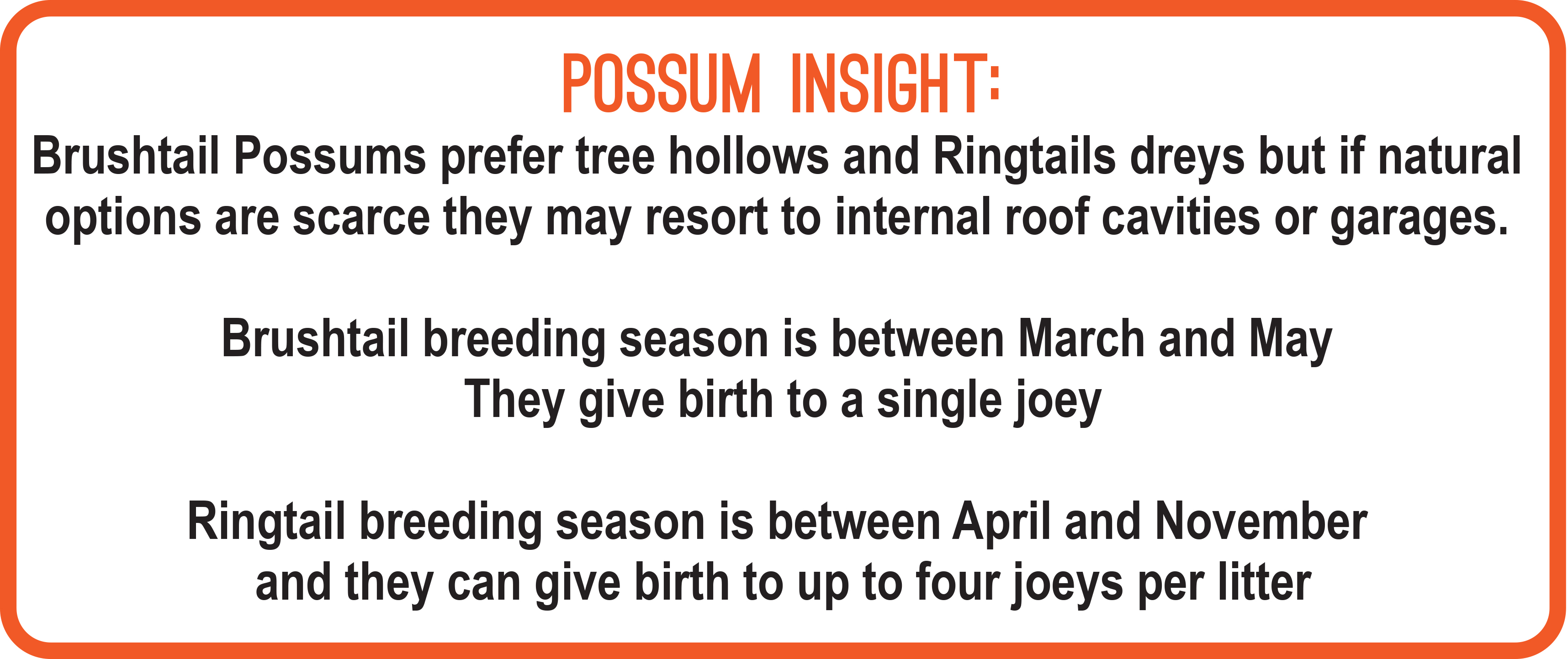
Related
Possum Defensive Mechanisms
When threatened, possums resort to various defensive mechanisms such as playing dead or 'playing possum', emitting a foul smell, and displaying their teeth and claws. These responses aim to deter potential threats rather than engage in physical conflict.
Possum Removal: Essential Techniques
Don't get disheartened if you've got possums in your roof. There are several effective and humane ways to remove them.
Catch-and-Release Possum Traps
A popular method is the use of catch-and-release traps. These devices capture possums without causing harm so they can be relocated safely from inside your building. These must be used in conjunction with possum proofing, or it will not be successful.
However, you must obtain a licence from the local governing body responsible for wildlife management.
RelatedProfessional Removal Services
If the problem persists or if you're uncomfortable handling possums, consider hiring a professional. Expert services have the knowledge and tools to handle possum removal safely.
Related
- Possum Removal: How to Get Rid of Possums Permanently
- Possum Removalists - How to Choose the Right Expert
Exclusion Techniques
Exclusion techniques can effectively keep possums out of certain areas. This involves installing barriers or modifying structures to prevent possums from accessing your property.
Related
Possum Repellent and Possum Deterrents
Possum invasions can be a nuisance, but there are proven ways to deter these animals. The first step is making your property less appealing.
This could include giving them their own home by installing a Possum Box, making it hard for them to climb trees as access points to your roof with Tree Guard, or blocking off gutters and Valleys with Gutter Guard and or Valley Guard.
Natural deterrents are another approach popular online; various claims are made with all sorts of homemade mixtures for managing unwanted visitors.
There is no conclusive evidence that any of these sprays or pastes work; it doesn't matter what you use; if a possum is hungry enough, they will ignore your efforts.
Making Your Home Less Inviting to Possums
A primary attraction for possums is food availability. To deter them from seeing your property as a feast waiting to happen, ensure rubbish bins are securely closed with possum-proof lids.
Compost heaps should be well-maintained; overripe fruits that fall off trees should be cleared regularly because they're an irresistible treat for hungry possums. You could also use wildlife-friendly netting over trees while they fruit.
Bird feeders also need attention since spilt seeds provide easy meals to both Possums and rodents. If possible, remove bird feeders at night when possums are most active.
Prune tree branches near your house so they are a minimum of 3m from the roofline, as they serve as access routes for possums onto rooftops.
Use Commercial Possum Deterrent Devices
Motion-triggered sprinklers or ultrasonic sound devices are another "famous on the internet" gimmick
These tools claim to work by releasing unexpected water blasts or high-pitched sounds that bother but don't hurt the Possums. However, there is no evidence these are effective in the long run.
Possum-Proofing Your Home
Possums in the roof? It's a common issue for many Australian homeowners.
These marsupials are drawn to the warmth and safety of our homes, but their presence can lead to issues like property damage and unwanted noise.
Sealing Off Entry Points
Your next line of defense involves securing entry points into your home. This might seem daunting given how nimble and flexible these creatures can be - some species can squeeze through openings just 10cm wide. But it's doable if approached methodically.
- Start by inspecting roof voids and any loose tiles – popular entry routes used by crafty possum intruders.
- Cover vents with strong snake-proof mesh, which allows air circulation while preventing animal access.
- Holes in eaves or roof lines and joins in the structure of the building should be sealed with possum-proof materials, preferably galvanised metal.
Tree Trimming and Other Modifications
If you've got trees close to your house, they might serve as possum highways. Regular trimming of branches within 3 metres of your home is recommended.
You could also consider installing a possum guard on tree trunks - this smooth metal or PVC band prevents them from climbing up into the canopy.
Related
Possum: The Benefits of Professional Removalists
Professional possum removal services offer a myriad of benefits, the most notable being their expertise and efficiency. But let's delve deeper into why it's worth hiring professionals for your possum problem.
Expert Knowledge
Professionals known as Possum Catchers or Possum Removalists have in-depth knowledge about different species of possums, their behaviour patterns, and nesting habits. This knowledge allows them to devise effective strategies for humane removal.
Safety Measures
Possessing wild animals is a risky business due to potential disease and parasite transmission or physical injuries. Professionals use protective gear and follow strict safety protocols to mitigate these risks.
Ethical Treatment & Legal Compliance
In many regions, laws govern how possums can be handled due to their protected status. Breaking these regulations can lead to hefty fines or even imprisonment.
A professional service will always comply with local legislation while ensuring the ethical treatment of these creatures. Each state Government offers detailed guidelines on handling possums humanely and legally within their state.
Preventive Measures
Besides removal, professionals also help with preventive measures such as sealing entry points or offering advice on making your property less attractive to possums.
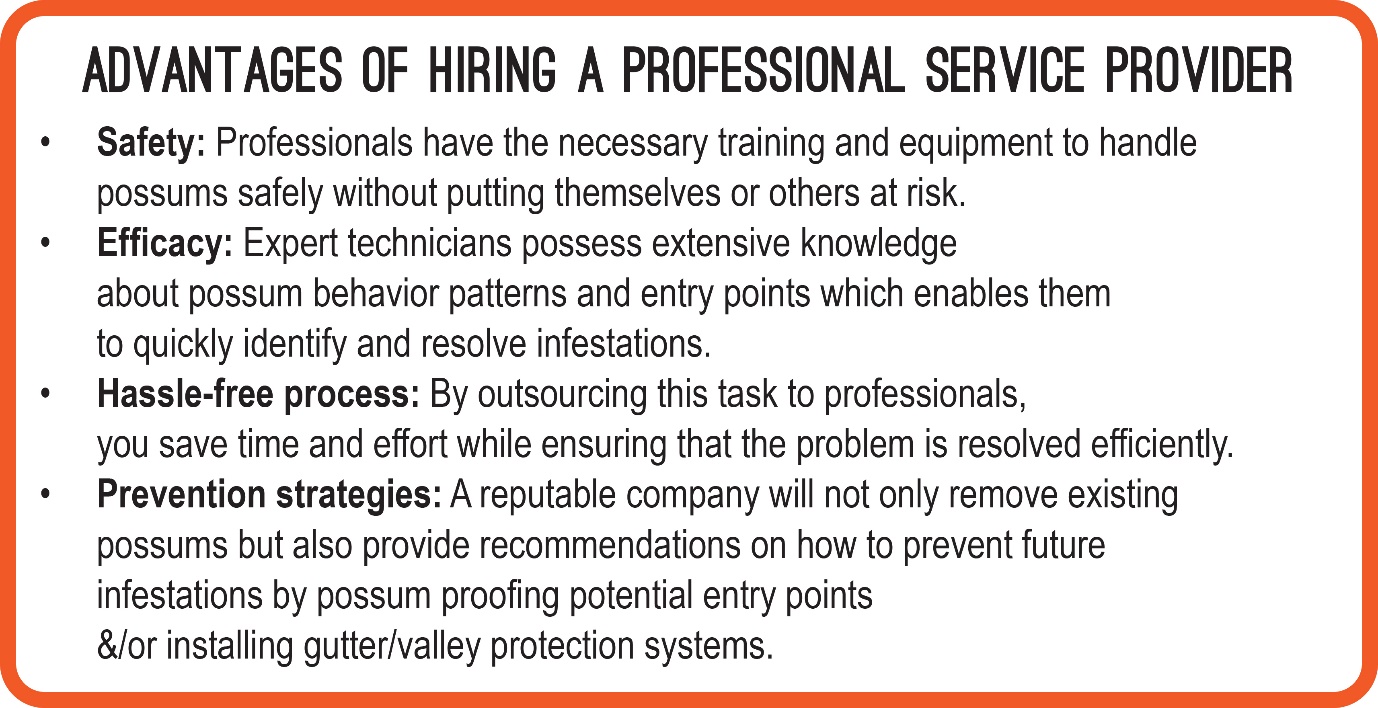
Managing a Dead Possum Dilemma
If the dead Possum is on public property, for instance, on the side of the road or median strip, you can call the local council to remove the carcass.
When it is on private property or in your roof cavity, if you don't want to handle the dead possum yourself, you will need to hire a company that specialises in dead animal removal services.
Possum removal companies usually provide this service; they can also possum-proof your building to prevent another possum from dying in the roof.
These trained individuals possess the knowledge and experience to identify and locate dead possums and dispose of them appropriately.
Related
Possum Catch and Release Licence Legalities
Possum control is a complex issue, tightly governed by specific laws in different regions. These rules ensure we treat possums humanely and protect their population numbers.
Possums are a protected species in Australia under the National Parks and Wildlife Act 1972. According to the law, it is illegal to kill, harm, or relocate possums beyond 25-150 meters from the capture location, varying distance based on the jurisdiction of each state.
To trap a possum in Australia, a Possum Catch & Release License is required by law. The various state government bodies throughout Australia issue these licenses.
Click on the state you live in for more information about the law regarding what you are legally allowed to do in regard to possums: NSW, VIC, SA, QLD, WA, TAS, ACT, and the NT.
Related
Protecting Yourself From Potential Risks Associated With Possums
Possums, though generally non-aggressive, can pose risks if mishandled or approached incorrectly. It's crucial to understand these dangers and take steps to protect yourself.
The Risk of Disease Transmission
Possums are not known to carry major diseases overall. However, they can be infested with parasites like lice, fleas, mites, and ticks that are disease spreaders.
There is one disease they may carry Tularemia – a rare infectious disease resulting in fever, skin ulcers and potentially pneumonia.
To safeguard against this risk, always wear gloves when handling anything possibly contaminated by possum droppings or urine. Better still, avoid direct contact where possible.
Potential Physical Injury
Apart from diseases, physical injuries may occur due to bites or scratches from an agitated possum. Their sharp teeth and claws aren't just for show.
These injuries might not only hurt but could also become infected if not treated promptly. Wash any wounds thoroughly as soon as they happen, and see a doctor for precautionary treatment, such as antibiotics and Tetanus inoculations.
Safety Precautions When Dealing with Possums
- If you encounter a possum on your property, maintain distance so as not to frighten it into defensive action.
- If removal is required from indoors or in the roof, do not attempt it alone. Contact local possum removal services with the proper training and equipment, or if it's injured, a wildlife rescue.
- Use preventative measures such as sealing off entry points to your home, thereby reducing the chance of a possum intrusion in the first place.
The Importance of Professional Intervention
It's a smart move to hire professionals for possum removal. They know what to look out for when finding entry points and will know how to seal them to make sure that Possum is gone from your roof for good.
They also have correct insurance, know the local wildlife laws and can safely handle wild animals, so you don't need to worry about those sharp claws!
Rodent Control: What Works?
If you have concluded you have rats or both rats and possums, it is time to think about the next steps to control the rodent activity
In Australia, two common rat species are found: the Brown rat, scientifically known as Rattus norvegicus, which goes by several nicknames such as street rat, sewer rat, wharf rat, Hanover rat, Norway rat, and Norwegian rat. It typically boasts a grey-brown colouration, a long tail, and prominent ears.
Effectively dealing with rodent issues begins with understanding these crafty creatures. Rats, as any experienced pest control company will tell you, are drawn to food and warmth. Thus, securing food storage and blocking cosy nesting spots are crucial initial steps.
The process of rodent control commences with a thorough property inspection. This entails checking for wall cracks, loose tiles, or any other potential entry points.
It's essential to seal off all openings larger than 25mm in diameter. While sealing access points helps manage rodent infestations, it's often prudent to incorporate rat baiting as well.
Pest control treatment plans often rely on bait as a tried and tested method to control rat populations. Choosing the right bait is critical, as it needs to appeal to rats and is among the quickest and most efficient rat control methods available.
Various bait types are available on the market, including grain-based baits, protein-based options, and sweet-tasting variants. Your selection should align with the preferences of the local rat population.
For safety, consider using tamper-resistant bait stations to keep pets and children away from potentially hazardous rat baits. These stations are designed to allow rats to enter freely while keeping larger animals out, thanks to their narrow entranceways.
DIY Rat Control
If you feel comfortable placing the bait stations yourself, you can purchase the professional grade bait and bait stations from diyratrid.com.au; they also have a handy free measuring tool so you know how many bait stations you will need for your building.
Related
- Rat Identification: Signs of Rodent Activity
- Rat Bait: Navigating Successful Pest Management
- How to Get Rid of Rats: Rodent Control Strategies that Work
- Rat Traps: The Ultimate Guide to Bait Free Rodent Control

Possum Frequently Asked Questions
Are Possums a pest in Australia?
In certain scenarios, yes. Possums can become pests when intruding into homes and gardens, causing damage or noise disruption, but they aren't classified as a pest like rodents or foxes as they are a protected species.
Are Australian Possums friendly?
Australian possums are typically non-aggressive, but they are wild animals. It's best not to approach them as their behaviour is unpredictable.
Are Possums a Danger?
Rarely. Although they will defend themselves if cornered and carry diseases like any other wild animal, the risk of transmission to humans is low unless you handle them directly.
What is the difference between a Ringtail possum and a Brushtail possum?
The most obvious difference is their tails; a brushtail has a big black bushy tail, compared to a ringtail, which is thin and has a noticeable white tip that takes up almost half the extended length.
What is the difference between an Opossum and an Australian possum?
The term "opossum" encompasses over 100 distinct species of marsupials located in North, Central, and South America, belonging to the families Didelphidae and Caenolestidae. This includes the Virginia Opossum, exclusive to North America.
On the other hand, "possum" refers to an even more diverse group, with around 67 marsupial species inhabiting Australia, as well as nearby islands in Papua New Guinea and Indonesia.
Falling under the suborder Phalangeriformes and spanning across six different families.
The main differences are in their appearances. An Opossum has a longer face and smaller eyes, a bare tail and different markings, including a white face.
The Australian Brushtail has a rounder, shorter face, thicker grey fur all over and a black bushy tail.

Can you touch an Australian Possum?
It's more a question of whether you should; unless they are injured or a juvenile that has fallen off their mother, you probably won't get a chance.
Adults will also defend themselves, so it would be best not to try unless they need help; in that instance, put a box over them for shelter and call a local wildlife rescue.
What is the most common possum in Australia?
There are two common possums in Australia: The Common Brushtail Possum and the Ringtail Possum
How many different types of possums are there?
There are 27 species of Possum and Glider in Australia. For a full list, see here.
Are possums protected in Australia?
Yes, possums are protected under the National Parks and Wildlife Act 1972; there will be additional legislation depending on which state you are in. Check the local laws before any removal processes are carried out.
How rare are Ringtail Possums?
Ringtail Possums are one of the two most common possums in Australia.
Will installing a barrier on powerlines prevent Possums from accessing my roof?
The belief that installing a barrier on the powerlines leading into a house or building will prevent possums from accessing the roof is commonly held, but it is incorrect.
Firstly, such a barrier would not effectively stop possums as they would easily jump over it. Additionally, it is important to note that this action is illegal.
How do you get rid of Possums permanently?
The only way to remove possums permanently is to possum-proof your building and remove them using either a one-way door or a Possum Trap.
A qualified Possum removalist will be able to assist, making sure you comply with legislation and don't miss any entry points.
Do WIRES remove possums from my roof?
No, WIRES are not a possum removal service. They are a wildlife rescue service, and they only assist with injured or sick animals/possums.
They are not equipped to deal with trapped possums; as volunteers without insurance, they are not allowed to climb ladders to access roof spaces.
To ensure your possum issues are successfully managed, hire a professional possum removal company that will not only remove the possum from your building but also ensure it is possum-proofed to prevent any further issues in the future.
If you have an injured or sick possum or any other wildlife, then WIRES are an option to call as they are a free community service.
Does the RSPCA remove possums from my roof?
No, the RSPCA are not a possum removal service. They are a rescue service for the most part, responsible for rehoming unwanted and neglected domestic animals through their shelters, educating the public about responsible pet ownership, and where possible, supporting injured wildlife
Does Sydney Wildlife Rescue remove possums from my roof?
No, Sydney Wildlife Rescue are a wildlife rescue service similar to WIRES and are also not equipped to deal with trapped possums; as volunteers without insurance, they are not allowed to climb ladders to access roof spaces
To ensure your possum issues are successfully managed, hire a professional possum removal company that will not only remove the possum from your building but also ensure it is possum-proofed to prevent any further issues in the future.
However, if you have an injured or sick possum or any other wildlife, then Sydney Wildlife are an option to call as they are a free community service.
Do Pest Control Companies Remove Possums from My Roof?
Most pest control companies only offer possum trapping services and do not provide any possum-proofing or prevention measures. Therefore, possum pest control is not the best option.
To ensure your possum issues are successfully managed, hire a professional possum removal company that will not only remove the possum from your building but also ensure it is possum-proofed to prevent any further issues in the future.
Conclusion
Possum sightings are common, but around your home they can cause real headaches.
Recognising the signs of possum activity and identifying their species is key. Understanding their behaviour helps us manage them effectively.
We've explored strategies for removing these marsupials humanely from your property and ways to deter future visits. Making your home less attractive to possums is essential, too!
The value of professional removal services cannot be overstated when dealing with infestations. Remember, though - local regulations matter in handling wildlife control.

